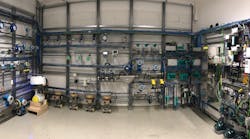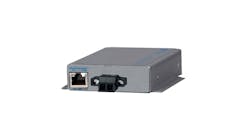So far, there are only two documented, user-based Ethernet-APL testbeds. The first at Procter & Gamble was covered by Control in last year’s version of this story. Here’s how BASF and its partners are adopting and testing Ethernet-APL for wider implementation in the future.
“It’s very important for us to test any new production technologies. We can’t simply trust they’ll work as expected because many applications are pioneering topics,” says Gerd Niedermayer, senior E&I engineering manager at BASF for its chemical plants and new plants in Europe. “We need to know if they’ll work properly or not, if they deliver the advantages they claim, and if they solve our problems.”
In the case of Ethernet-APL, BASF researched it in 2017-18, and built its field test lab in 2019-20 at its headquarters in Ludwigshafen, Germany, to evaluate communications using Profinet protocol over Ethernet-APL (Figure 1). To test how Ethernet-APL would work with its applications, Niedermayer reports that BASF worked closely with several suppliers, including ABB, Emerson, Endress+Hauser, HIMA, Krone, Samson, Siemens and Yokogawa. They provided the lab with mass and magnetic inductive flowmeters, level, pressure and temperature transmitters, three to five valve positioners for each application, full sensor sets, and other components needed to equip a process plant.
“Ethernet-APL is attractive because it lets us easily connect all these devices, download data from them, and exchange data with their DCSs,” explains Niedermayer. “Where we previously had to deal with polarity requirements and if we were connecting the right green or red wire, we no longer have to care about many of these connection issues or which direction they’re going. Plus, using Ethernet-APL gives us 10 Mbps, which is a lot faster than Profibus PA’s 31.25 kbps.”
Speed paves links more devices
Because it’s much faster, Ethernet-APL can reach more field-level components, such sensors, instruments and transmitters and other field devices. At BASF’s field test lab, Ethernet-APL connects via Profinet to redundant controllers via field switches with eight, 16 or 24 ports. These two controllers include Honeywell’s Experion DCS and ABB’s 800 xA DCS, which are connected to 238 field devices in a Profinet ring/loop topology via 24-port field switches that can handle 24 devices each (Figure 3). Of course, one of Ethernet-APL’s main advantages is its two-wire loop can run up to 200 meters in intrinsically safe (IS) settings with Ex ia potentially explosive atmospheres, where Ethernet couldn’t go before.
“Because we work with so many motor control centers (MCC) and variable frequency drives (VFD), one of BASF’s primary goals for the field test lab was having at least two interfaces for each of the two controllers, which would also let us manage electrical equipment over Ethernet with Profinet protocol,” adds Niedermayer. “We also wanted our ring network to standardize on Profinet to reach all these devices, and use Ethernet-APL in the intrinsically safe areas.”
Development and testing
To test Ethernet-based equipment and models, the field lab at BASF implements new components in its field devices or switches, which is helping its supplier partners develop Ethernet-APL products. For example, in mid-2022, it installed and beta tested several Endress+Hauser items with standardized Ethernet-APL chips and two-wire Ethernet communications. This is expected to let Endress+Hauser release Ethernet-APL products in 2Q23, with other vendors project to follow shortly after.
More recently, Niedermayer reports BASF and its partners conducted a scalability test of the field lab in mid-March. The team tested 40 criteria and scenarios using its standard devices and full ring network’s communications stack and memory, and found their operations were very stable. The ring was examined with communications tracking software from Indu-Sol and Procentec, which can monitor network traffic performance and identify problems.
“We’re helping develop Ethernet-APL products because BASF is very interested in it. We believe it has big advantages for three new plants we’re doing detailed engineering for now, which are scheduled to start up in 2025,” says Niedermayer. “These advantages are that it’s simpler, enables plug-and-play, and makes it easier exchange field devices, along with allowing two-wire Ethernet to serve in intrinsically safe areas.”
Simplicity saves time—and inspires
Niedermayer adds that BASF’s prior networking efforts usually started at the field device with 4-20 mA, and most still do. However, this traditional networking requires analog-to-digital (A/D) conversion, digital-to-analog (D/A) conversion, voltage and power, signal marshalling and conversion, and A/D conversion again to reach the DCS.
“With Ethernet-APL in the field, we make one A/D conversion to reach a field switch, and that’s all! These Ethernet-APL switches, such as those that Pepperl+Fuchs, Phoenix Contact and R. Stahl are making, can connect via the ring right to a controller, and again, that’s all!” says Niedermayer. “This is a lot simpler, which is especially helpful when we’re starting a plant because we can see all the loops when we connect to the asset management station. We also don’t need to do as many field tests and measurements to do loop checks to measure ranges in the DCS, which also means we don’t need to go into the field as much anymore because the process values are fully digital. This reduces our loop check times by about 80%, which is our present expectation and also lets us start plants sooner.”
Beyond its speed and reach, Niedermayer adds that Ethernet-APL also has more bandwidth than typical networking methods, so participating devices can easily transmit and receive data in parallel to asset management systems and redundant controllers on the same wire and at the same time. This is possible with other protocols like Foundation Fieldbus and Profibus PA, but their bandwidth is comparatively limited.
“Previously, we couldn’t do what we wanted with our networks due to 4-20 mA’s limited bandwidth,” adds Niedermayer. “With Ethernet-APL, we can do what’s needed, just as we can get Ethernet into hazardous areas. In fact, Ethernet-APL also allows us to bring in ProfiSafe protocol for safety applications along with Profinet in future safety applications. This lets users communicate with safety PLCs via Ethernet-APL and the ProfiSafe stack. Of course, safety applications will likely continue to maintain separate networks and redundant devices, but the advantage now is that they can employ the same network structure and topology, and use the same field devices.”





